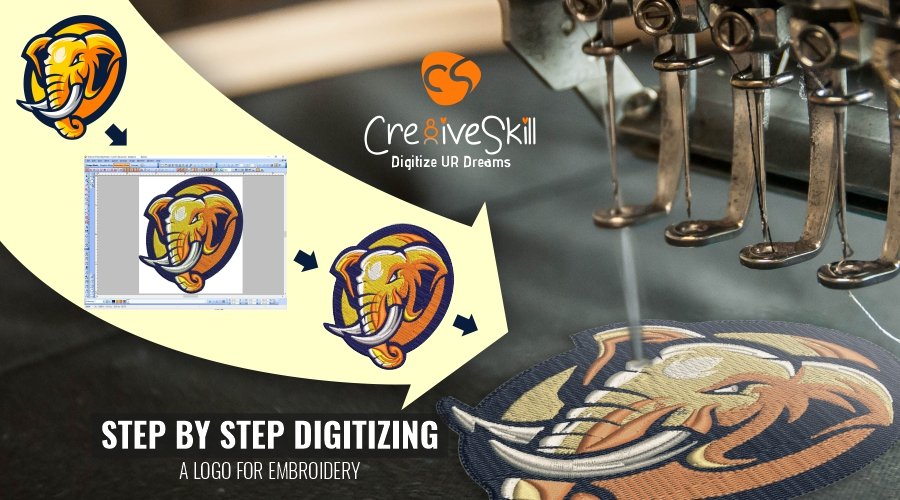High-Quality Digitizing for Embroidery: Expert Workmanship
High-Quality Digitizing for Embroidery: Expert Workmanship
Blog Article
Simplifying the Art of Embroidery Digitizing: Step-by-Step Overview
Embroidery digitizing is a careful craft that requires accuracy and creative thinking. As modern technology continues to advancement, the digitization process has actually ended up being much more obtainable, permitting fanatics to bring their detailed designs to life with ease. In this overview, we will untangle the complexities of needlework digitizing, breaking down each step systematically to simplify the process and encourage both beginners and experienced embroiderers alike. Remain tuned to uncover exactly how you can streamline this detailed art kind and transform your innovative visions right into beautifully embroidered masterpieces.
Comprehending Needlework Digitizing Software Application
Embroidery digitizing software application works as a crucial device for transforming complex styles into digital styles suitable with needlework devices, facilitating exact sewing and personalization. This specialized software permits users to import numerous image documents styles, such as JPG or PNG, and convert them into needlework machine-readable layouts like DST, EXP, or PES - Digitizing for Embroidery. By using features like stitch editing, rug options, and string shade option, digitizing software program enables individuals to control every facet of the design procedure
In addition, advanced embroidery digitizing software program offers devices for producing complex designs, adjusting stitch thickness, and including complex details. Users can likewise preview the style prior to stitching it out, making sure precision and decreasing errors. Furthermore, many software application provide automated functions that assist enhance the digitizing process, saving effort and time.
Understanding the abilities of needlework digitizing software is vital for accomplishing high-quality cause embroidery tasks. By grasping this device, needlework lovers and experts can unleash their creativity and bring detailed designs to life with accuracy and performance.

Picking the Right Design File
After acquainting on your own with the capabilities of embroidery digitizing software program, the following vital action in the process is picking the ideal design data for your task. Digitizing for Embroidery. When picking a layout file for embroidery digitizing, it's crucial to think about the intricacy of the design, the size of the end product, and the sort of fabric you will certainly be collaborating with
For detailed designs with fine details, a high-resolution photo or vector documents is recommended to ensure that the needlework equipment can accurately reproduce the style. In addition, the dimension of the end product plays a significant duty in choosing the appropriate layout file. Bigger styles might require higher resolution data to maintain clearness and intensity.
Additionally, the sort of material you will be stitching on influences the choice of layout file. Different textiles might need adjustments in the style file to make sure that the stitches are appropriately aligned and the style looks like planned. By meticulously picking the appropriate layout data based upon these factors, you can set yourself up for an effective needlework digitizing process.
Digitizing Devices and Techniques
Utilizing specialized software program and accuracy techniques, digitizing tools are crucial in transforming elaborate designs into embroidery-ready data. Needlework digitizing software program, such as Wilcom, Hatch, or Embrilliance, gives the necessary platform to convert artwork into stitch information. These programs provide functions like stitch editing, rug alternatives, and text devices to make certain the layout converts seamlessly onto fabric.
One of the essential methods in digitizing is producing a clear course for the needlework maker to comply with. This includes digitizing each aspect of the style with precision, figuring out stitch kinds, densities, and instructions. By utilizing devices like digitizing tablets or software-specific plugins, embroiderers can achieve a high level of precision in their digitized layouts.
Moreover, mastering the art of padding stitching is vital for creating high quality embroidery. Underlay sewing maintains the material and produces a foundation for the style, making certain that the last product is both aesthetically enticing and resilient. By comprehending these digitizing tools and strategies, embroiderers can raise their craft and bring detailed designs to life with accuracy and effectiveness.
Personalizing Stitch Kinds and Instructions
The option of stitch types can dramatically affect the total appearance and appearance of the embroidered style. By purposefully combining these stitch types, embroiderers can attain depth and dimension in their layouts.
Furthermore, the instructions of stitches plays an important duty click this site in enhancing the visual charm of the last embroidery. Numerous stitch directions can add structure, emphasize specific aspects, and develop aesthetic interest. Changing the angle of stitches can mimic motion or all-natural this contact form patterns like hair or plumes. By experimenting with different stitch angles and patterns, embroiderers can bring their styles to life with impressive information and intricacy. Mastering the art of tailoring stitch kinds and instructions encourages embroiderers to release their creative thinking and boost the quality of their work.
Testing and Refining Your Digitized Design
To guarantee the accuracy and quality of your digitized design, comprehensive testing and refinement are essential action in the needlework digitizing procedure. Once you have finished the digitization of your layout, it is critical to evaluate it before continuing with the actual embroidery. Testing permits you to recognize any type of prospective issues such as string breaks, sew thickness issues, or style distortions that may influence the result.

After testing, it is necessary to improve your digitized design based on the feedback from the examination sew-out. This might include tweaking stitch setups, changing thickness, or making adjustments to the total style to achieve the wanted result. By iterating via screening and refinement, you can adjust your digitized design to excellence prior to progressing with the actual embroidery procedure.
Conclusion
In verdict, grasping the art of embroidery digitizing requires an extensive understanding of the software, picking the ideal design data, utilizing digitizing devices and techniques, tailoring stitch types and directions, and look at this now testing and fine-tuning the digitized design. By complying with these steps, embroiderers can streamline the digitizing procedure and produce top quality stitched designs with accuracy and performance.
Report this page